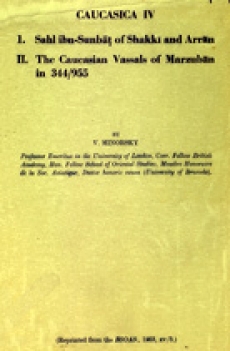|
CAUCASICA IV
By V. Minorsky
THE territory of the present-day Soviet republic of Azarbayjan roughly corresponds to the ancient Caucasian Albania (in Armenian Alovan-V, or Alvan-k', in Arabic Arrdn > al-Rari). Twenty-six languages were spoken in Albania and it had its own kings (Strabo, xi, 4). However, during the seven centuries between Pompey's expedition in 66-5 B.C., to which we owe most of our information on the ancient life of the country, and the Arab invasion in the 7th century a.d., great changes had taken place in the area, under the influence of the Persian expansion up to the Caucasian passes, the Khazar and Alan inroads from the north, and the Armenian cultural activities which resulted in the conversion of the surviving Albanians to the Armenian form of Christianity. The Arab geographers refer to the Arranian language as still spoken in the neighbourhood of Barda'a (Persian : Perdz-dbddh, Armenian Partav), but now only the two villages inhabited by the Udi 1 are considered as the direct continuators of the Albanian linguistic tradition.
Our object being the study of the conditions in the 9th-10th centuries, we are not concerned with the further great changes brought about by the invasion of the Turkish Oghuz in the 11th century and the subsequent Turkicization of the area.
Both the Armenian and the Arabic sources show that the Arab occupation did not do away with the old Arranian and Armenian dynasties, which continued their existence as vassals of the conquerors. Profiting by every occasion to assert their hereditary rights, they succeeded in ' tiding over ' the Arabs, the Seljuks, and the Mongols, and even now the so-called 'Qarabagh highlands' form an autonomous area within the Soviet Republic of Azarbayjan.2
The period of decline of the semi-independent principalities presents great difficulties for study. Both in Arabic 3 and Armenian 4 sources the light is turned on to special episodes and we are left to conjecture as to the connecting links. The work of the indigenous historian of ' Albania ', Moses Kalankatvats'i, who wrote in Armenian (10th century), contains many important data, but his obscure hints and sudden breaks in the main thread are often exasperating.5 A particular complication results from the contemporary Armenian fashion of assuming Arabic patronymics (kunya) (such as Abu-Musa, Abul-Asad, etc.), ...
1 Cf. Plinius, X.H., 6, 13, 16: Otene; Arm. Geography : Uti. This ancient province extended probably on both banks of the Kur, whereas the surviving villages lie in the Shakkl district near to the passes leading into southern Daghestan.
2 To say nothing of the numerous Armenian villages in the whole of Eastern Transcaucasia.
3 Baladhuri (d. 279/892), Ya'qubi (d. 284/897), Tabari (d. 311/923).
4 Thomas Artsruni (before a.d. 1000), Asolik (soon after a.d. 1000) and some later historians, like Stephannos Orbelian (about a.d. 1300).
5 I am using his History of Albania in the Russian translation of K. Patkanian, St. Petersburg, 1861 ; for a number of clarifications I am obliged to Mr. C. Dowsett, who is preparing a new edition of the Armenian text.
For the author's bibliography see BSOAS, XIV/3, 1952, pp. 669-681.
Recent publications :
Studies in Caucasian History, Cambridge, 1953 (170 + 19 pp.). (In collaboration with Mrs. T. Minorsky) Translation of Kratchkovsky's Among Arabic manuscripts, Leiden, 1952, 195 pp.
Aynallu/Inallu, Rocznik Orientalistyczny, Krakow, 1953, XVII, 1-11.
In the press :
Abu-Dulafs Second Risala (Arabic text and Commentary), Cairo.
An outline of the history of Islamic Persia, Rome. |
